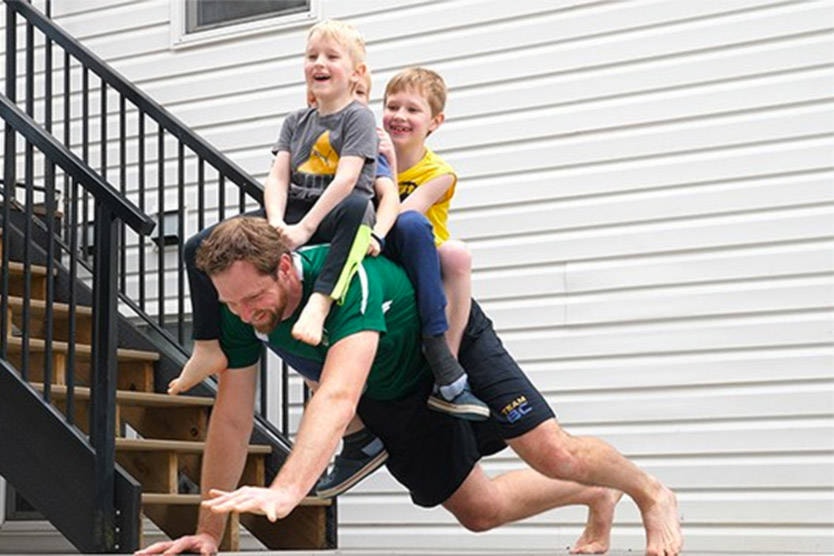Have you been staying active during the pandemic? If so, locally created study found you’re not just doing your body good, but your mental health as well.
As people around the world retreated to their homes in an attempt to avoid the spread of COVID-19, researchers from the University of the Fraser Valley wondered what the impact would be on physical activity. The results of their survey are now published in a study titled The Impact of COVID-19 on Physical Activity Behavior and Well-Being of Canadians.
Their study results show that those who became more active during the pandemic had lower anxiety than those who spent less time in outdoor physical activity. They also found that the restrictions imposed by the pandemic, such as parks and recreational facility closures, made it more difficult for some people to be as active as they would have liked to be.
Two researchers from UFV’s kinesiology department, Dr. Iris Lesser and Carl Nienhuis, surveyed Canadians to find out how people adapted their fitness activities to this new restricted reality.
“The pandemic resulted in restrictions to daily living for Canadians, including social distancing and closure of city and provincial recreation facilities, national parks, and playgrounds. We wanted to assess how these preemptive measures impacted physical activity behaviour and well-being of Canadians,” Lesser notes.
Canadians were still allowed to go outdoors for walking, running, and cycling activity, as well as pursuing indoor exercise in their homes.
Results of their Life in Lockdown survey indicate that while 40.5 per cent of previously inactive individuals became less active, only 22.4 per cent of active individuals became less active. Comparatively, 33 per cent of inactive individuals became more active while 40.3 per cent of active individuals became more active.
There were significant differences in well-being outcomes in the inactive population between those who were more active, the same, or less active, but this was not seen in the active population. Inactive participants who spent more time engaged in outdoor physical activity had lower anxiety than those who spent less time in outdoor physical activity.
Since COVID-19 restrictions were in place, 28.3 per cent of inactive participants altered their physical activity type, while 39.6 per cent of active participants maintained their typical physical activity choice.
READ MORE: Nature and exercise combine for UFV study
Findings show that those who were less active in the early weeks of social isolation reported less enjoyment of life. For some, maintaining their physical activity was a challenge because of the restrictions imposed by the pandemic.
“For both the active and inactive population, there was a significant difference between those that were less active and those that reported the same or more physical activity since COVID-19 restrictions. That is, those that were less active for both inactive and active populations reported significantly less benefit, less enjoyment, less confidence, less support and fewer opportunities to be active. Further, those that were less active indicated significantly more challenges in physical activity engagement,” notes Lesser.
Lesser sees the effects of the pandemic on the activity level of the population as an opportunity to learn about barriers faced by some, and to reinforce the importance of promoting physical activity.
“I was surprised by the number of differences between inactive and active participants in how COVID-19 affected physical activity behaviour. I think this highlights the importance of lifestyle in promoting physical activity and how it is not a lack of willingness on the part of individuals to engage in physical activity but the number of barriers that they may be experiencing.
“Given the association between well-being among inactive participants who became more active since COVID-19, it further supports the need to promote physical activity for optimal mental and physical well-being.”
This study aligns with other research Lesser is conducting on the impact of outdoor activities on the anxiety levels of cancer survivors.
“There were significant differences within the inactive group between classification of anxiety levels and number of minutes spent in outdoor physical activity. Inactive participants with severe anxiety spent significantly fewer minutes in outdoor physical activity than participants with low and mild anxiety,” she notes. “I was pleased to see that finding as it supports the work that I am doing with cancer survivors and the importance of engaging in physical activity in an outdoor environment.”
As for what we can learn from the public health measures taken during the pandemic?
“While preventive public health measures are necessary during a pandemic such as this, an understanding of the impact on mental wellbeing of outdoor spaces for physical activity should be part a factor when it comes to making decisions about the ways in which we restrict outdoor access,” she says.
“Public health measures differentially affected Canadians who were active and inactive. Physical activity was strongly associated with well-being outcomes in inactive individuals. This suggests that health-promoting measures directed towards inactive individuals may be essential to improving well-being.”
READ MORE: Cancer anxiety research program returns for spring hikes
@CHWKcommunity
jpeters@theprogress.com
Like us on Facebook and follow us on Twitter.
Want to support local journalism during the pandemic? Make a donation here.
